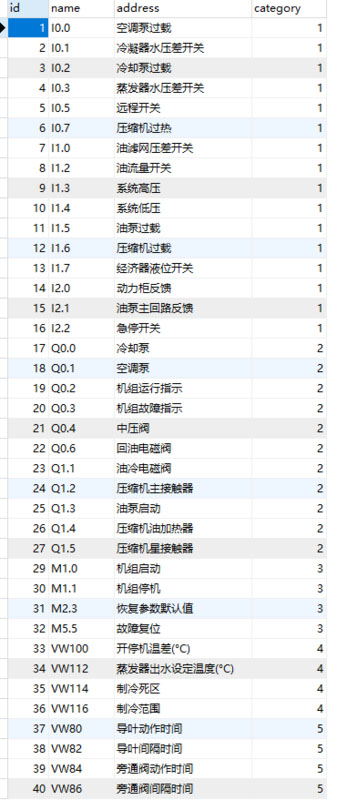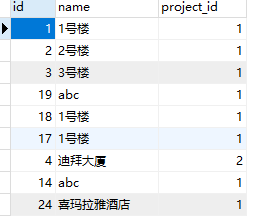您好,登錄后才能下訂單哦!
您好,登錄后才能下訂單哦!
前言
本文主要給大家介紹的是關于obix協議在java中的配置和使用,分享出來供大家參考學習,下面話不多說了,來一起看看詳細的介紹吧。
什么是 oBIX?
簡單來講,obix是一種 XML 通訊協議,使用Http Request/Post方式進行數據通訊。所有數據通過可讀字符進行傳送,一個oBIX對象可以有唯一的一個URL識別。
oBIX的實現原理
首先數據儲存在Niagara的服務平臺上,我們需要做的是從Niagara獲取數據,并且儲存在InfluxDB中。下面是實現的流程方法。
我們都需要定義哪些類以及變量?
| 類/接口 名 | 用途 |
|---|---|
| Calculator | |
| DiscoverEngine | 搜索工具 |
| FactorInfo | 定義所采集元素的信息 |
| FactorNameDecoderInterface | 元素名稱解碼接口 |
| FactorNameDecoderObixUrlImpl | |
| NewValueInterface | |
| NewValueInterfaceImpl | |
| ObixClientMgr | |
| ObixClient | |
| ObixFetcher | 循環抓取obix傳輸的數據 |
1、遍歷各個點

2、先遍歷各個設備,將相同的typeid的設備存入同一個hashmap中

3、開始執行主程序,先從數據庫中查詢出項目名稱

4、開始搜索!
public class ObixFetcher implements JobInterface{
//這個是接口的抽象方法
public void cycleOnce() {
//從數據庫中取出項目信息
List<Project> ps = dao.selectByExample(new ProjectExample());
//遍歷項目信息,如果項目信息的關鍵信息不為null
for(Project p : ps){
if(p.getObixBaseAddress() != null && p.getObixUsername() != null
&& p.getObixPassword() != null){
//開啟探索工具 (應該還是一個內部類),將關鍵項目信息傳入探索工具,
DiscoverEngine de = new DiscoverEngine(p.getObixBaseAddress(),
p.getObixUsername(), p.getObixPassword());
//從build數據庫中將數據取出,存入bulidNameToId(同樣還是構造方法)
//從device數據庫中將數據取出,存入deviceNumberToId(同樣還是構造方法)
de.setNewValueInterface(new NewValueInterfaceImpl(p.getId(), deviceService, deviceDao, deviceTypeDao, buildDao));
//return回來一個FactorInfo
de.setFactorNameDecoderInterface(new FactorNameDecoderObixUrlImpl());
de.run();
}
}
}
}
以下是上文 DiscoverEngine de的構造方法
public class DiscoverEngine {
public DiscoverEngine(String baseUrl, String username, String password){
this.baseUrl = baseUrl;
obixClient = new ObixClient(baseUrl, username, password);
}
}
以下是上文obixClient = new ObixClient(baseUrl, username, password)的構造方法
public class ObixClient {
public ObixClient(String baseUrl, String userName, String password){
this.baseUrl = baseUrl;
this.userName = userName;
this.password = password;
init();
}
//uri中存放著路由地址,然后傳給session,session會在后面用到
private void init() {
Uri uri = new Uri(baseUrl);
session = new ObixSession (uri, userName, password);
}
}
this就是說這個類的當前這個對象,也就是構造方法產生的對象。
以下信息好像并沒有用到
public class NewValueInterfaceImpl implements NewValueInterface{
HashMap<String, Integer> buildNameToId = new HashMap<String, Integer>();
HashMap<String, Integer> deviceNumberToId = new HashMap<String, Integer>();
public NewValueInterfaceImpl(Integer projectId, IDeviceManagementService deviceService, DeviceMapper deviceDao, DeviceTypeMapper deviceTypeDao,BuildMapper buildDao) {
this.deviceDao = deviceDao;
this.deviceTypeDao = deviceTypeDao;
this.buildDao = buildDao;
this.projectId = projectId;
this.deviceService = deviceService;
//遍歷數據庫中的建筑,存入map
List<Build> bs = buildDao.selectByExample(new BuildExample());
for(Build b : bs){
buildNameToId.put(b.getName(), b.getId());
}
//遍歷數據庫中的設備,存入map
List<Device> ds = deviceDao.selectByExample(new DeviceExample());
for(Device d : ds){
deviceNumberToId.put(d.getNumber(), d.getId());
}
}
}

以上信息好像并沒有用到
接著跑了下面兩個接口
還沒搞懂什么意思以下
public class DiscoverEngine {
//此處一直用內部類來實現,上面定義了一個匿名內部類,此處給匿名內部類賦值
public void setNewValueInterface(NewValueInterface inft){
newValueInterface = inft;
}
//同上
public void setFactorNameDecoderInterface(FactorNameDecoderInterface inft){
factorNameDecoderInterface = inft;
}
}
以上
然后開始無情的 run 起來這個搜索工具
public class DiscoverEngine {
//首先傳進來url地址
public void run(){
readUrl(baseUrl);
}
public void readUrl(String url){
// System.out.println("processing url " + url);
//此處用到session方法
Obj obj = obixClient.read(url);
if(obj == null){
return;
}
//新建一個Obj,用于儲存 out 所對應的 value
Obj outObj = obj.get("out");//此處的out是儲存的值(理解成標簽的ID)
if(outObj != null){
//如果****那么就新建一個fi 將項目信息分項保存
if(this.factorNameDecoderInterface != null){
FactorInfo fi = factorNameDecoderInterface.decode(obj.getHref().get());
if(newValueInterface != null && fi != null){
//如果信息不為空,我們就要準備存讀出來的數了
newValueInterface.onNewValue(fi, outObj.toString());
}
}
}
else{
for(Obj o : obj.list()){
readUrl(url + o.getHref());
}
}
}
}
下面用到了session
public class ObixClient {
public Obj read(String url){
try {
//根據我們傳進去的url中讀出一個obj,這個obj如果有value,就返回一個數,否則就返回地址 />
Obj obj = session.read(new Uri(url));
return obj;
} catch (Exception e) {
e.printStackTrace();
return null;
}
}
}
將URL地址中的信息分項保存
public class FactorNameDecoderObixUrlImpl implements FactorNameDecoderInterface{
@Override
public FactorInfo decode(String url) {
String[] tokens = url.split(":")[2].split("\\/");
//新建一個 對象 將url中解析出的信息分享保存到這個對象中
FactorInfo fi = new FactorInfo();
fi.setDeviceName(tokens[tokens.length - 2]);
fi.setDeviceTypeName(tokens[tokens.length - 3]);
fi.setFactorName(tokens[tokens.length - 1]);
fi.setBuildName("");
fi.setFloorName("");
fi.setProjectName("");
return fi;
}
}
public class NewValueInterfaceImpl implements NewValueInterface{
static ConcurrentHashMap<String, Long> dataInfluxTime = new ConcurrentHashMap<String, Long>();
DeviceMapper deviceDao;
IDeviceManagementService deviceService;
DeviceTypeMapper deviceTypeDao;
BuildMapper buildDao;
Integer projectId;
HashMap<String, Integer> buildNameToId = new HashMap<String, Integer>();
HashMap<String, Integer> deviceNumberToId = new HashMap<String, Integer>();
public NewValueInterfaceImpl(Integer projectId, IDeviceManagementService deviceService, DeviceMapper deviceDao, DeviceTypeMapper deviceTypeDao,BuildMapper buildDao) {
this.deviceDao = deviceDao;
this.deviceTypeDao = deviceTypeDao;
this.buildDao = buildDao;
this.projectId = projectId;
this.deviceService = deviceService;
List<Build> bs = buildDao.selectByExample(new BuildExample());
for(Build b : bs){
buildNameToId.put(b.getName(), b.getId());
}
List<Device> ds = deviceDao.selectByExample(new DeviceExample());
for(Device d : ds){
deviceNumberToId.put(d.getNumber(), d.getId());
}
}
@Override
public void onNewValue(FactorInfo fi, String value) {
//先將URL中的設備名稱信息取出來,然后再取出對應的ID
String number = fi.getDeviceName();
Integer deviceId = deviceNumberToId.get(number);
if(deviceId == null){
number = fi.getDeviceName();
Device record = new Device();
record.setName(number);
record.setNumber(number);
record.setProjectId(projectId);
record.setTypeId(fi.getDeviceTypeId());
deviceService.insert(record );
deviceId = record.getId();
System.out.println("found new device id=" + deviceId + ", name=" + number);
deviceNumberToId.put(number, deviceId);
}
Double val = null;
//然后將ID存入device中
Device updateRecord = new Device();
updateRecord.setId(deviceId);
//將取出的值也存入device
try{
Double d = Double.parseDouble(value);
updateRecord.setCurrentValue(d.intValue());
val = d;
}
catch(Exception e){
if(value.equalsIgnoreCase("true")){
updateRecord.setCurrentValue(1);
val = 1.0;
}
else if(value.equalsIgnoreCase("false")){
updateRecord.setCurrentValue(0);
val = 0.0;
}
}
if(updateRecord.getCurrentValue() != null){
deviceDao.updateByPrimaryKeySelective(updateRecord );
}
//將所得所得數據存入influxDB
try{
String timeKey = projectId+"_"+deviceId+"_"+fi.getFactorName();
Long t = dataInfluxTime.get(timeKey);
if(t == null) t = new Long(0);
Long now = System.currentTimeMillis();
if(now - t > 10 * 60 * 1000){
InfluxDBUtil.insert(projectId, deviceId, convert10Minutes(now), fi.getFactorName(), val);
dataInfluxTime.put(timeKey, now);
}
}
catch(Exception e){
e.printStackTrace();
}
}
總結
以上就是這篇文章的全部內容了,希望本文的內容對大家的學習或者工作能帶來一定的幫助,如果有疑問大家可以留言交流,謝謝大家對億速云的支持。
免責聲明:本站發布的內容(圖片、視頻和文字)以原創、轉載和分享為主,文章觀點不代表本網站立場,如果涉及侵權請聯系站長郵箱:is@yisu.com進行舉報,并提供相關證據,一經查實,將立刻刪除涉嫌侵權內容。